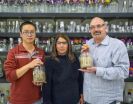3D microchip created
New type of microchip created which not only moves information from left to right and back to front, but up and down as well
2013-01-31
(Press-News.org) Scientists from the University of Cambridge have created, for the first time, a new type of microchip which allows information to travel in three dimensions. Currently, microchips can only pass digital information in a very limited way - from either left to right or front to back. The research was published today, 31 January, in Nature.
Dr Reinoud Lavrijsen, an author on the paper from the University of Cambridge, said: "Today's chips are like bungalows – everything happens on the same floor. We've created the stairways allowing information to pass between floors."
Researchers believe that in the future a 3D microchip would enable additional storage capacity on chips by allowing information to be spread across several layers instead of being compacted into one layer, as is currently the case.
For the research, the Cambridge scientists used a special type of microchip called a spintronic chip which exploits the electron's tiny magnetic moment or 'spin' (unlike the majority of today's chips which use charge-based electronic technology). Spintronic chips are increasingly being used in computers, and it is widely believed that within the next few years they will become the standard memory chip.
To create the microchip, the researchers used an experimental technique called 'sputtering'. They effectively made a club-sandwich on a silicon chip of cobalt, platinum and ruthenium atoms. The cobalt and platinum atoms store the digital information in a similar way to how a hard disk drive stores data. The ruthenium atoms act as messengers, communicating that information between neighbouring layers of cobalt and platinum. Each of the layers is only a few atoms thick.
They then used a laser technique called MOKE to probe the data content of the different layers. As they switched a magnetic field on and off they saw in the MOKE signal the data climbing layer by layer from the bottom of the chip to the top. They then confirmed the results using a different measurement method.
Professor Russell Cowburn, lead researcher of the study from the Cavendish Laboratory, the University of Cambridge's Department of Physics, said: "Each step on our spintronic staircase is only a few atoms high. I find it amazing that by using nanotechnology not only can we build structures with such precision in the lab but also using advanced laser instruments we can actually see the data climbing this nano-staircase step by step.
"This is a great example of the power of advanced materials science. Traditionally, we would use a series of electronic transistors to move data like this. We've been able to achieve the same effect just by combining different basic elements such as cobalt, platinum and ruthenium. This is the 21st century way of building things – harnessing the basic power of elements and materials to give built-in functionality."
###The research was funded by the European Research Council and the Netherlands Organisation for Scientific Research (NWO).
For additional information please contact:
Genevieve Maul, Office of Communications, University of Cambridge
Tel: direct, +44 (0) 1223 765542, +44 (0) 1223 332300
Mob: +44 (0) 7774 017464
Email: Genevieve.maul@admin.cam.ac.uk
Notes to editors:
1. The paper 'Magnetic ratchet for 3-dimensional spintronic memory
and logic' will be published in the 31 January 2013 edition of Nature.
2. Image available upon request. Please credit LindenArtWork www.lindenartwork.com.
ELSE PRESS RELEASES FROM THIS DATE:
2013-01-31
A natural disaster can bring out the best in older children, prompting 9-year-olds to be more willing to share, while 6-year-olds become more selfish. Researchers at the University of Toronto, the University of Chicago, and Liaoning Normal University made this finding in a rare natural experiment in China around the time of a horrific earthquake.
A crucial difference between the two age groups emerged one month after the disaster. The 6-year-olds' willingness to share in a test measuring altruism dropped by a third, while among 9-year-olds, willingness to give to others ...
2013-01-31
In this month's edition of Physics World, science writer Richard Corfield casts doubt on the alleged "brainwashing" of the late British astronomer Sir Bernard Lovell by the Soviets at the height of the Cold War and explains how his trips beyond the Iron Curtain laid the foundations for the easing of geopolitical tensions between the UK and the USSR.
Speaking to Lovell's son Bryan, Corfield reveals a more mundane explanation for why Lovell, who founded the Jodrell Bank telescope in the UK, fell ill on his return from the USSR in 1963.
"For me the more likely explanation ...
2013-01-31
A study of young twins in Malawi, in sub-Saharan Africa, finds that bacteria living in the intestine are an underlying cause of a form of severe acute childhood malnutrition.
The research, led by Washington University School of Medicine in St. Louis and reported Feb. 1 in the journal Science, shows how dysfunctional communities of gut microbes conspire with a poor diet to trigger malnutrition.
The discovery is bolstered by additional studies in mice, showing that gut microbes transplanted from malnourished children cause dramatic weight loss and alter metabolism when ...
2013-01-31
Winemakers have long known that blending different grape varietals can favorably balance the flavor characteristics of the wine they produce. In the future, makers of advanced biofuels might use a similar strategy, blending different feedstock varieties to balance the energy characteristics of the transportation fuel they produce.
A collaborative study by researchers with the U.S. Department of Energy (DOE)'s Joint BioEnergy Institute (JBEI), a bioenergy research center led by Berkeley Lab, and the Idaho National Laboratory (INL) has shown that an ionic liquid proven ...
2013-01-31
Jan. 30 2013 - Scientists have long known that cattle produce carbon dioxide and methane throughout their lives, but a new study pinpoints the cow-calf stage as a major contributor of greenhouse gases during beef production.
In a new paper for the Journal of Animal Science, scientists estimate greenhouse gas emissions from beef cattle during different stages of life. They show that, depending on which production system farmers used, beef production has a carbon footprint ranging from 10.7 to 22.6 kg of carbon dioxide equivalent per kg of hot carcass weight.
According ...
2013-01-31
PROVIDENCE, R.I. [Brown University] — Ecology is rife with predation, competition, and other dramatic "negative interactions," but those alone do not determine the course life on Earth. Organisms sometimes benefit each other, too, and according to the Stress Gradient Hypothesis, their "positive interactions" become measurably more influential when ecosystems become threatened by conditions such as drought. Ecologists have argued about the hypothesis ever since Brown University ecologist Mark Bertness co-proposed it in 1994; Bertness says a large new global meta-analysis ...
2013-01-31
Peers exert a greater influence on teenage girls' dissatisfaction with their bodies than do thin ideals in television or social media use, according to new research¹ by Dr. Christopher J. Ferguson and colleagues from Texas A&M International University in the U.S. Their study is published online in Springer's Journal of Youth and Adolescence.
The influence of the media on body image, life satisfaction, and symptoms of eating disorders in teenage girls is a hot debate. Some experts believe that media influences on body dissatisfaction may extend to symptoms of eating disorders. ...
2013-01-31
LAS VEGAS, Nev. — Lake Mead National Recreation Area's water quality is good, the sport fish populations are sufficient, and the lakes provide important habitat for an increasing number of birds. This positive trend is documented in a new report published today that leads to a better understanding of the natural resources of Lake Mead and Lake Mohave, and the issues that may affect natural resource management of Lake Mead NRA.
"While the Lake Mead ecosystem is generally healthy and robust, the minor problems documented in the report are all being addressed by the appropriate ...
2013-01-31
Like many fungi and one-celled organisms, Candida albicans, a normally harmless microbe that can turn deadly, has long been thought to reproduce without sexual mating. But a new study by Professor Judith Berman and colleagues at the University of Minnesota and Tel Aviv University shows that C. albicans is capable of sexual reproduction.
The finding, published online by Nature January 30, represents an important breakthrough in understanding how this pathogen has been shaped by evolution, which could suggest strategies for preventing and treating the often serious infections ...
2013-01-31
New Rochelle, NY, January 30, 2013—Metabolic syndrome is more likely to affect children who are obese than overweight or non-overweight and who have other characteristics associated with the disorder, such as high blood pressure or insulin resistance. A new comprehensive and systematic review of the medical literature on metabolic syndrome in children that probed deeper to evaluate the risk associated with gender, ethnicity, and geography was published in Metabolic Syndrome and Related Disorders, a peer-reviewed journal from Mary Ann Liebert, Inc., publishers. The article ...
LAST 30 PRESS RELEASES:
[Press-News.org] 3D microchip created
New type of microchip created which not only moves information from left to right and back to front, but up and down as well




